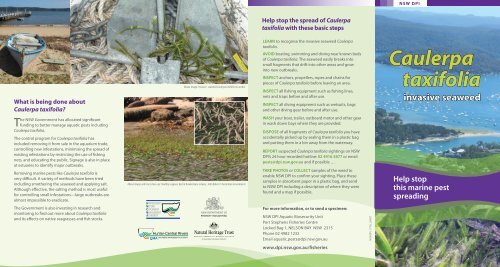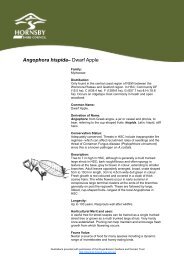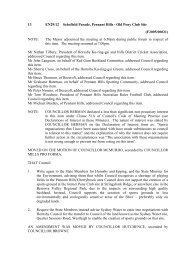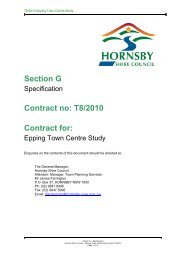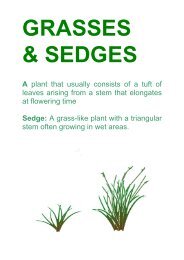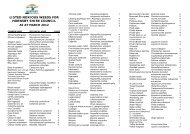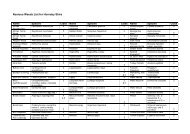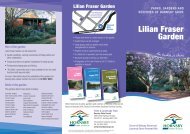Caulerpa Taxifolia invasive seaweed brochure - NSW Government
Caulerpa Taxifolia invasive seaweed brochure - NSW Government
Caulerpa Taxifolia invasive seaweed brochure - NSW Government
You also want an ePaper? Increase the reach of your titles
YUMPU automatically turns print PDFs into web optimized ePapers that Google loves.
What is being done about<br />
<strong>Caulerpa</strong> taxifolia?<br />
The <strong>NSW</strong> <strong>Government</strong> has allocated significant<br />
funding to better manage aquatic pests including<br />
<strong>Caulerpa</strong> taxifolia.<br />
The control program for <strong>Caulerpa</strong> taxifolia has<br />
included removing it from sale in the aquarium trade,<br />
controlling new infestations, minimising the spread of<br />
existing infestations by restricting the use of fishing<br />
nets, and educating the public. Signage is also in place<br />
at estuaries to identify major outbreaks.<br />
Removing marine pests like <strong>Caulerpa</strong> taxifolia is<br />
very difficult. A variety of methods have been tried<br />
including smothering the <strong>seaweed</strong> and applying salt.<br />
Although effective, the salting method is most useful<br />
for controlling small infestations—large outbreaks are<br />
almost impossible to eradicate.<br />
The <strong>Government</strong> is also investing in research and<br />
monitoring to find out more about <strong>Caulerpa</strong> taxifolia<br />
and its effects on native seagrasses and fish stocks.<br />
Above image: Invasive <strong>seaweed</strong> <strong>Caulerpa</strong> taxifolia on anchor<br />
Above image and inset close-up: Healthy seagrass bed in Hawkesbury estuary. John Baker © Australian <strong>Government</strong><br />
Help stop the spread of <strong>Caulerpa</strong><br />
taxifolia with these basic steps<br />
LEARN to recognise the <strong>invasive</strong> <strong>seaweed</strong> <strong>Caulerpa</strong><br />
taxifolia.<br />
AVOID boating, swimming and diving near known beds<br />
of <strong>Caulerpa</strong> taxifolia. The <strong>seaweed</strong> easily breaks into<br />
small fragments that drift into other areas and grow<br />
into new outbreaks.<br />
INSPECT anchors, propellers, ropes and chains for<br />
pieces of <strong>Caulerpa</strong> taxifolia before leaving an area.<br />
INSPECT all fishing equipment such as fishing lines,<br />
nets and traps before and after use.<br />
INSPECT all diving equipment such as wetsuits, bags<br />
and other diving gear before and after use.<br />
WASH your boat, trailer, outboard motor and other gear<br />
in wash down bays where they are provided.<br />
DISPOSE of all fragments of <strong>Caulerpa</strong> taxifolia you have<br />
accidentally picked up by sealing them in a plastic bag<br />
and putting them in a bin away from the waterway.<br />
REPORT suspected <strong>Caulerpa</strong> taxifolia sightings on <strong>NSW</strong><br />
DPI’s 24 hour recorded hotline: 02 4916 3877 or email<br />
pests@dpi.nsw.gov.au and if possible …<br />
TAKE PHOTOS or COLLECT samples of the weed to<br />
enable <strong>NSW</strong> DPI to confirm your sighting. Place these<br />
samples in absorbent paper in a plastic bag, and send<br />
to <strong>NSW</strong> DPI including a description of where they were<br />
found and a map if possible.<br />
For more information, or to send a specimen:<br />
<strong>NSW</strong> DPI Aquatic Biosecurity Unit<br />
Port Stephens Fisheries Centre<br />
Locked Bag 1, NELSON BAY <strong>NSW</strong> 2315<br />
Phone 02 4982 1232<br />
Email aquatic.pests@dpi.nsw.gov.au<br />
www.dpi.nsw.gov.au/fisheries<br />
<strong>NSW</strong>DPI_7776_JUN07<br />
N S W D P I<br />
<strong>Caulerpa</strong><br />
taxifolia<br />
<strong>invasive</strong> <strong>seaweed</strong><br />
Help stop<br />
this marine pest<br />
spreading<br />
a newsletter from the nsw recreational fishing trusts
What is <strong>Caulerpa</strong> taxifolia?<br />
<strong>Caulerpa</strong> taxifolia is a fast growing marine<br />
<strong>seaweed</strong> normally found in warm tropical<br />
waters in northern Australia.<br />
But now this marine <strong>seaweed</strong> has invaded<br />
some of the <strong>NSW</strong> coast’s most popular fishing<br />
and boating havens.<br />
Transported through fishing, recreational<br />
boating, wind and wave action, and in the<br />
past by the aquarium trade, <strong>Caulerpa</strong> taxifolia<br />
has the potential to permanently alter our<br />
beautiful estuaries and bays.<br />
stolon<br />
frond and pinnules<br />
rhizoids<br />
Above image: <strong>Caulerpa</strong> taxifolia. Alan Millar, Royal Botanic Gardens, Sydney<br />
Why should you care about it?<br />
Whether it’s fishing, sailing, cruising, kayaking or scuba<br />
diving, being out on the water in <strong>NSW</strong> is great fun.<br />
But as well as being wonderful places to visit and enjoy,<br />
our waterways are also fragile ecosystems that many local<br />
communities heavily rely on for tourism, aquaculture, and<br />
recreational and commercial fishing.<br />
<strong>Caulerpa</strong> taxifolia is a threat to our native marine<br />
environment. It spreads quickly, is very difficult to<br />
eradicate and can potentially impact native seagrasses and<br />
possibly reduce fish stocks.<br />
With long, creeping runners and fern-like fronds, <strong>Caulerpa</strong><br />
taxifolia can easily become entangled in boating and<br />
fishing equipment.<br />
It can grow from small fragments accidentally carried<br />
by recreational boaters and other waterway users.<br />
<strong>Caulerpa</strong> taxifolia can stay alive for several days in damp<br />
environments such as anchor wells, nets and wetsuits,<br />
growing into new plants if returned to the water.<br />
In some cases boating, anchoring or fishing closures may<br />
have to be put in place in <strong>Caulerpa</strong> taxifolia affected areas<br />
– a situation everybody wants to avoid.<br />
Your help is needed NOW!<br />
Be alert to this pest<br />
and contact us when you see it.<br />
Where is it now?<br />
<strong>Caulerpa</strong> taxifolia has been recorded in several estuaries<br />
and lakes in <strong>NSW</strong>, including the popular fishing and<br />
boating havens of Pittwater, Hawkesbury River and<br />
Brisbane Water just north of Sydney.<br />
See the <strong>NSW</strong> DPI website or contact the Aquatic<br />
Biosecurity Unit for up-to-date information on the<br />
location of <strong>Caulerpa</strong> taxifolia in <strong>NSW</strong> estuaries.<br />
Pittwater<br />
<strong>Caulerpa</strong> taxifolia was first discovered in Careel Bay,<br />
Pittwater in 2002 and is now widespread throughout the<br />
estuary. Affected areas include the eastern and western<br />
shores south of the entrance to Pittwater, Careel Bay,<br />
Scotland Island and off Bayview in the south of the estuary.<br />
For up-to-date information about fishing closures and<br />
legal fishing methods in Pittwater, contact the Sydney<br />
North Fisheries Office on (02) 8437 4903.<br />
Hawkesbury River<br />
Since 2006 <strong>Caulerpa</strong> taxifolia has been found at the<br />
eastern end of Patonga Beach and at the entrance to<br />
Patonga Creek. Both areas are on the northern side of the<br />
mouth of the Hawkesbury River.<br />
For up-to-date information about fishing closures and<br />
legal fishing methods in the Hawkesbury River, contact<br />
the Brooklyn Fisheries Office on (02) 4348 1900.<br />
Brisbane Water<br />
In 2006 <strong>Caulerpa</strong> taxifolia was discovered in several areas<br />
of Brisbane Water including Ettalong Beach, Booker Bay<br />
and the north western point of St Huberts Island.<br />
For up-to-date information about fishing closures and<br />
legal fishing methods in Brisbane Water, contact the<br />
Central Coast Fisheries Office on (02) 4348 1900.


